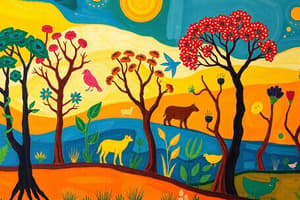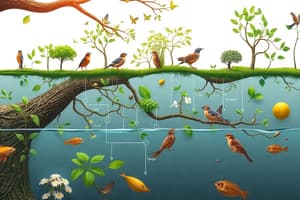Podcast
Questions and Answers
Which of the following is an abiotic factor in an ecosystem?
Which of the following is an abiotic factor in an ecosystem?
- Bacteria
- Plants
- Animals
- Water (correct)
All living beings adapt to their environment in the same way.
All living beings adapt to their environment in the same way.
False (B)
What are the two main types of components in an ecosystem?
What are the two main types of components in an ecosystem?
Biotic and abiotic
A __________ is a sequence of organisms where each one is eaten by the next in the chain.
A __________ is a sequence of organisms where each one is eaten by the next in the chain.
Match the type of ecosystem with its description:
Match the type of ecosystem with its description:
Flashcards are hidden until you start studying
Study Notes
Organized Living Beings
- Organisms are classified into different categories based on their characteristics and functions.
- Living beings can be unicellular (single-celled) or multicellular (many-celled), including plants, animals, fungi, and microorganisms.
Biotic and Abiotic Factors
- Biotic factors are all the living components of an ecosystem, such as animals, plants, and bacteria.
- Abiotic factors are non-living elements like sunlight, water, soil, temperature, and air, which influence living organisms.
Ecosystem
- An ecosystem is a community of living organisms interacting with their environment.
- Ecosystems can be large (like forests and oceans) or small (like ponds and gardens), and they maintain balance through energy flow and nutrient cycling.
Living Beings Adaptations
- Adaptations are traits that enhance the survival and reproduction of organisms in their specific environments.
- Examples include camouflage in animals, drought resistance in plants, and specialized feeding behaviors.
Types of Ecosystems
- Major types of ecosystems include terrestrial (forests, deserts, grasslands) and aquatic (freshwater, marine).
- Each ecosystem hosts unique communities of organisms that have adapted to their specific environments.
Food Chain
- A food chain illustrates the flow of energy from one organism to another in an ecosystem.
- Typically starts with producers (plants), followed by primary consumers (herbivores), and then secondary and tertiary consumers (carnivores), ending with decomposers that recycle nutrients back into the soil.
Studying That Suits You
Use AI to generate personalized quizzes and flashcards to suit your learning preferences.




